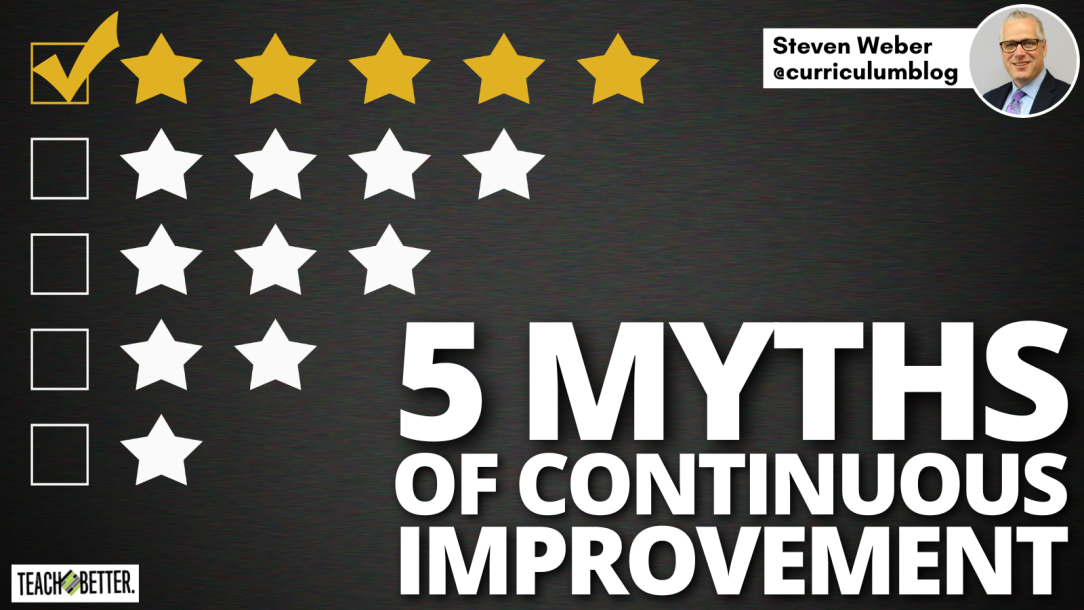TL;DR:
- Find the right priorities and develop goals around those priorities.
- What do we want students to be able to do?
- What are the learning targets?
- How do we determine progress?
- Don’t wait for all staff to be on board.
- Allow all staff to have a voice.
Success of Students
The work of school teams determines the success of the students we serve. School teams are focused on implementing the written, taught, and assessed curriculum in an effort to support student understanding. Elementary schools are traditionally organized as grade-level teams, while secondary schools operate as a department. “We certainly have to be purposeful, attentive, and professional in examining all aspects that contribute to the success, or lack thereof, in student learning and instructional practice” (Rose, 2013). If school teams are in pursuit of the wrong goals and priorities, they may enjoy the journey without reaching the ultimate destination.
Find a Target
During the first weeks of school, school teams are eager to meet the students and begin a new school year. Principals often form committees such as the School Improvement Team, Response to Intervention (RtI) Team, Guiding Coalition, Department Chair Meeting, and/or School Leadership Team. “The job is not to hope that optimal learning will occur, based on our curriculum and initial teaching. The job is to ensure that learning occurs, and when it doesn’t, to intervene in altering the syllabus and instruction decisively, quickly, and often” (Wiggins & McTighe, 2007, p. 55). Without clarity of purpose and clear goals, it is easy for school teams to drift before the end of the first quarter. When school teams drift from a common purpose and their collective commitments, students receive a disjointed curriculum and the aims of education become blurred.
Without clarity of purpose and clear goals, it is easy for school teams to drift. Click To TweetThree Questions That Help School Teams Avoid Drift
- What do we want all students to know and be able to do as a result of completing this lesson/unit? (The End in Mind)
- What are the Learning Targets? (The Bull’s Eye)
- How will we measure student progress and understanding? (The Evidence)
As school teams wrestle with the Three Questions That Help School Teams Avoid Drift, they will encounter multiple perspectives and different views on how to achieve continuous improvement. Chasing after the myths of continuous improvement can become a barrier to supporting the critically important work of school teams.
Myth #1 of Continuous Improvement: Success Is a Result of 100% Staff Buy-In
Waiting for all staff to have buy-in is an exercise in futility. There will be different opinions when it comes to instructional strategies, materials, and programs. It is rare that all staff will agree on the appropriateness of a strategy or program. Rogers and Smith (2020) shared that school teams need to move from “buy-in” to establishing “collective commitments.”
“Commitment to a decision also signals more than just agreement. To be committed, staff members must have clarity about what they are committing to and why. True commitment means that team members have a clear ‘reason for being’” (Rogers and Smith, 2020).
Which collective commitments has your school team made?
Myth #2 of Continuous Improvement: Veteran Teachers Have All of the Answers
Most veteran teachers realize that a novice teacher has much to offer the profession. It is rare that rookie hazing takes place or that a novice teacher is ignored in a planning meeting. When a grade level team or department honors and values each person’s professional experiences and perspective, collaboration and trust are more likely to occur. School districts and principals have been guilty of leaving novice teachers (years 1-3) off School Improvement Teams, Leadership Teams, or Guiding Coalitions. It is important to see through the lens of each staff member. “In the beginner’s mind there are many possibilities, but in the expert’s there are few” (Suzuki, 2020). If novice teachers do not have the opportunity to share their voice, their perspective may be missing from decisions that impact teaching and learning.
Do novice teachers have a seat at the leadership table?
It is important to see through the lens of each staff member. Click To TweetMyth #3 of Continuous Improvement: The Principal Is the Instructional Leader
The building principal has been referred to as the Lead Learner, Coach, Supervisor, and Instructional Leader. The role of the principal is to hire highly qualified professionals and to place them in the right seat on the bus. There is no denying that the principal should be an instructional leader. “Your job as a leader is to be right at the end of the meeting, not at the beginning of the meeting. It’s your job to flush out all the facts, all the opinions…because you’ll get measured on whether you made a good decision, not whether it was your idea at the beginning” (Cote, as cited in Fullan, 2020). If the principal attempts to make decisions related to instruction and does not listen to the staff, it will have a negative impact on school culture and student growth.
Are you the instructional leader or are you building an instructional leadership team?
[scroll down to keep reading]Myth #4 of Continuous Improvement: Return on Investment Is Measured By Meeting Minutes
Meeting minutes document the topics discussed and action items or collective commitments. Meeting minutes may even outline a strategy for school teams. Too often, principals and school teams measure progress by the length of the meeting minutes. If a school team overemphasizes meeting minutes, they may be blinded by motion masquerading as progress. To avoid this mistake, refer back to the Three Questions That Help School Teams Avoid Drift. “While most organizations have a plan, few of them have a strategy. A plan is just an account of who will do what and when. By contrast, a strategy is a tight, cogent set of ideas about how best to fulfill the mission of the organization” (Stevenson, 2019).
Does our school team have a plan or a strategy?
Myth #5 of Continuous Improvement: The Absence of Conflict Equals a High-Performing Team
In the classic leadership book titled The Five Dysfunctions of a Team, Lencioni (2002) described how several teams view success in the absence of conflict. In theory, if a school team does not argue and the members of the different grade levels respect one another, then it is thought to be a successful meeting. School teams need to have hard conversations about students who are not reading at grade level. Student attendance, student engagement, and the effectiveness of the taught curriculum should also bring out lively conversation and a sense of urgency. “The courage to address tough topics comes from a deep commitment. No deep commitment, no hard dialogue” (Muhammad & Hollie, 2012).
What does our school team have a sense of urgency about and what hard conversations need to take place this week?
References
Cote, D. (2013). In Fullan, M. (2020). Leading in a culture of change (2nd ed.), (p, 46). John Wiley & Sons, Inc.
Lencioni, P. M. (2002). The five dysfunctions of a team. Jossey-Bass.
Muhammad, A., & Hollie, S. (2012). The will to lead, the skill to teach: Transforming schools at every level. Bloomington: Solution Tree Press, a division of Solution Tree.
Rogers, P., & Smith, W.R. (2020, May 12). Buy-in or commitment: Where is your staff? Solution Tree. Retrieved from https://www.solutiontree.com/blog/buy-in-or-commitment-where-is-your-staff/
Rose, A. (2013, February 15). Data-informed versus data-driven PLC teams. Solution Tree. Retrieved from https://www.allthingsplc.info/blog/view/209/data-informed-versus-data-driven-plc-teams
Stevenson, I. (2019). An improvement plan is not enough — you need a strategy. Phi Delta Kappan,
100(6), 60-64.
Suzuki, S. (2020). Zen mind, beginner’s mind: Informal talks on Zen meditation and practice. Shambhala Publications, Inc.
Wiggins, G., & McTighe, J. (2007). Schooling by design: Mission, action & achievement. Association for Supervision and Curriculum Development.
About Steven Weber
Dr. Steven Weber is the Associate Superintendent for Teaching and Learning with Fayetteville Public Schools (AR). His areas of research include curriculum design, formative assessment, professional learning, and school leadership.




